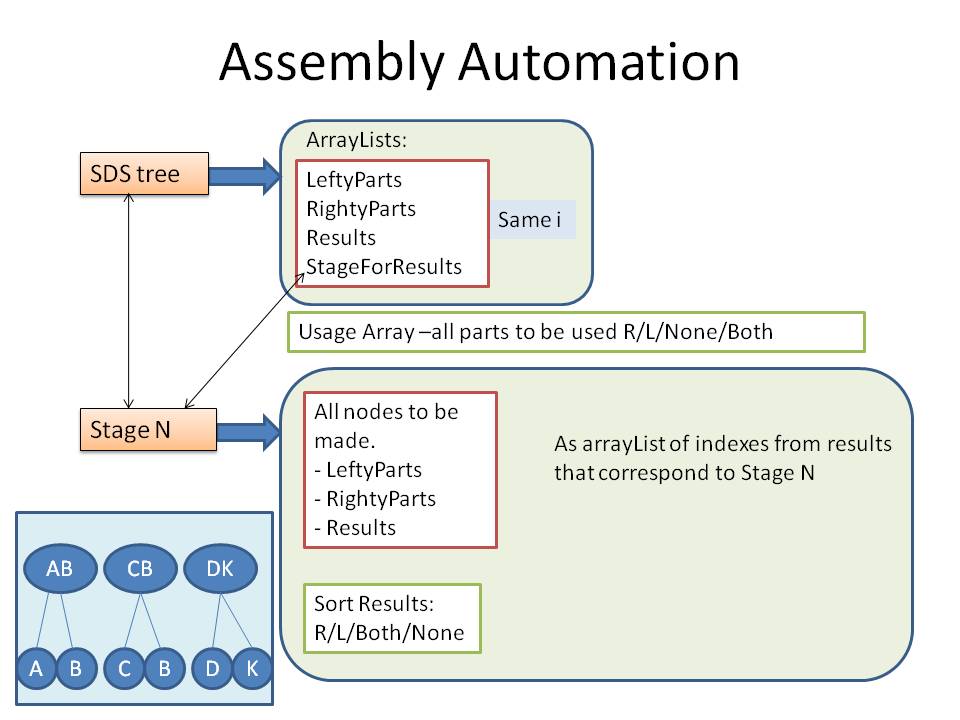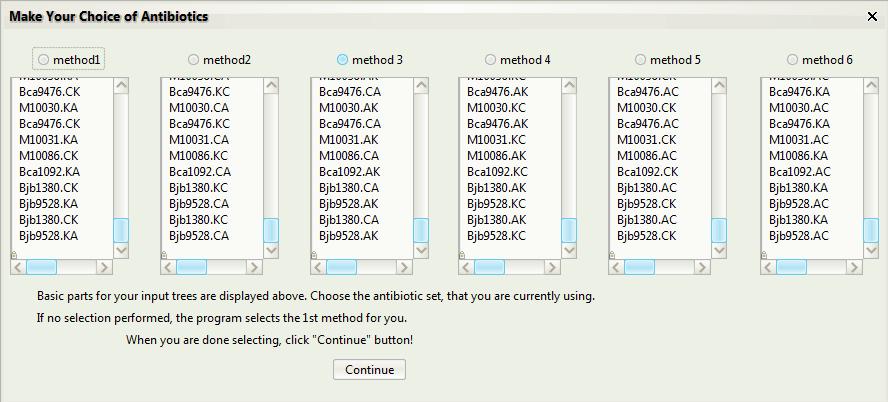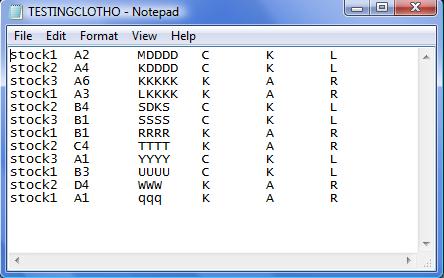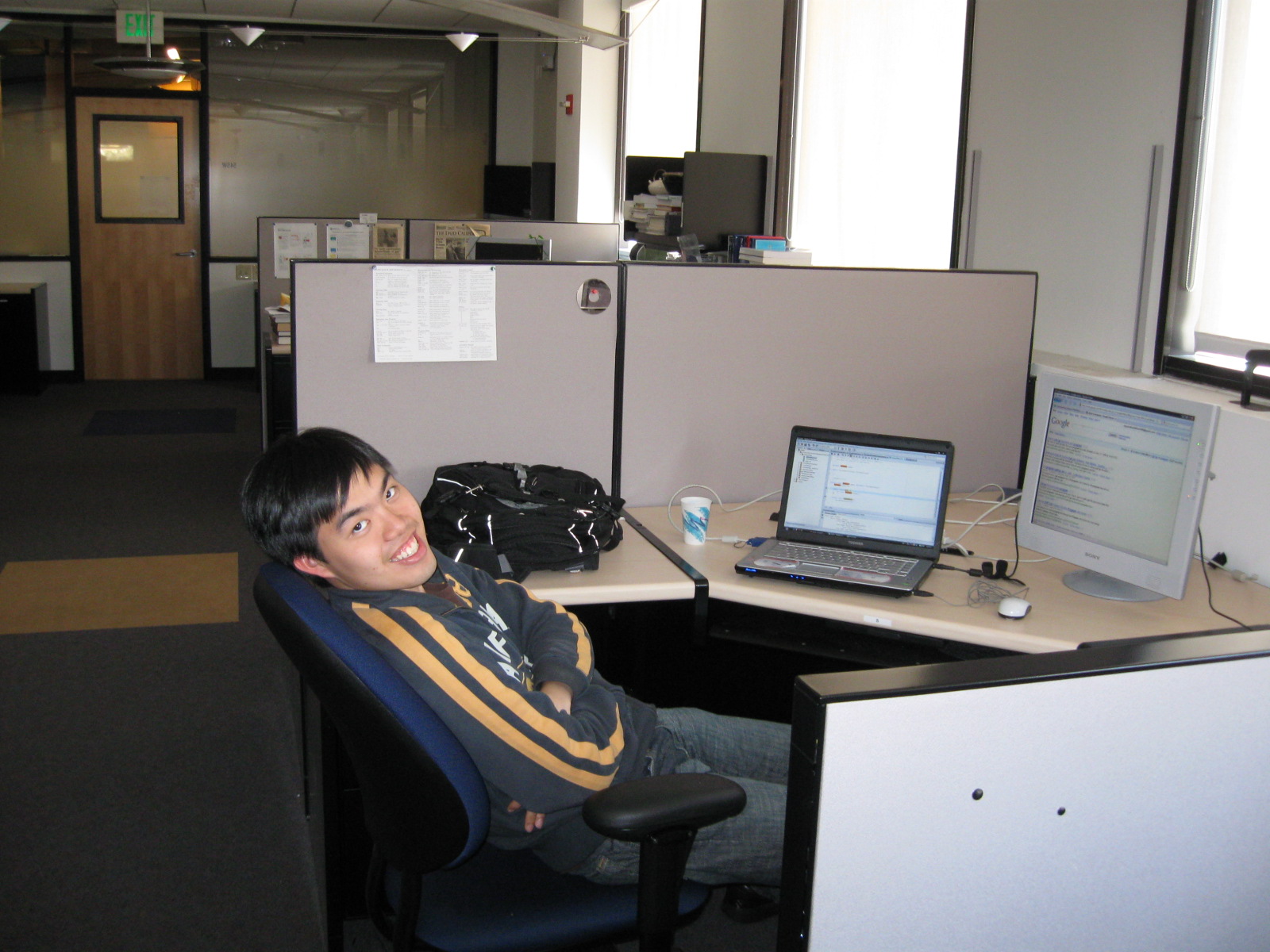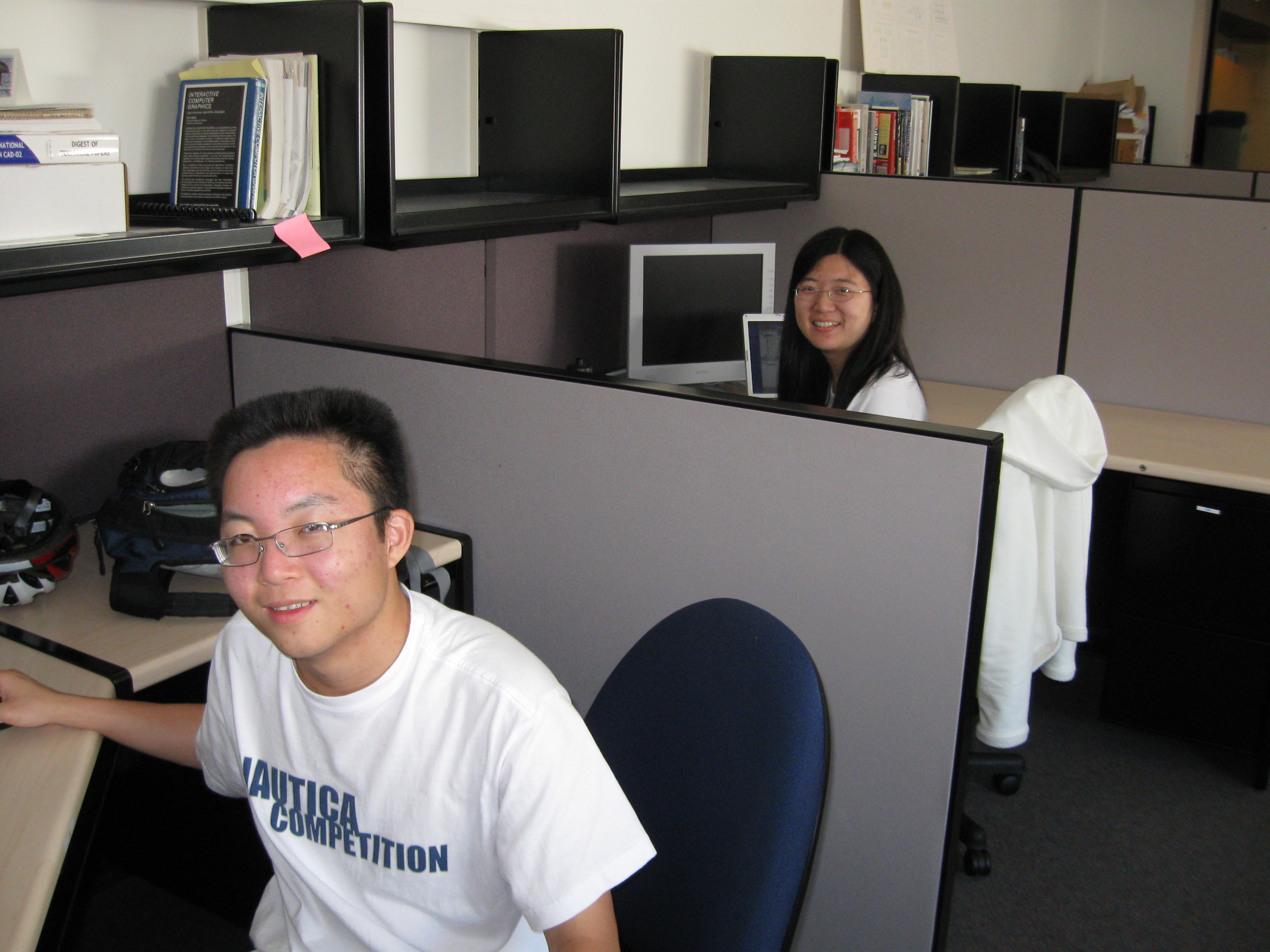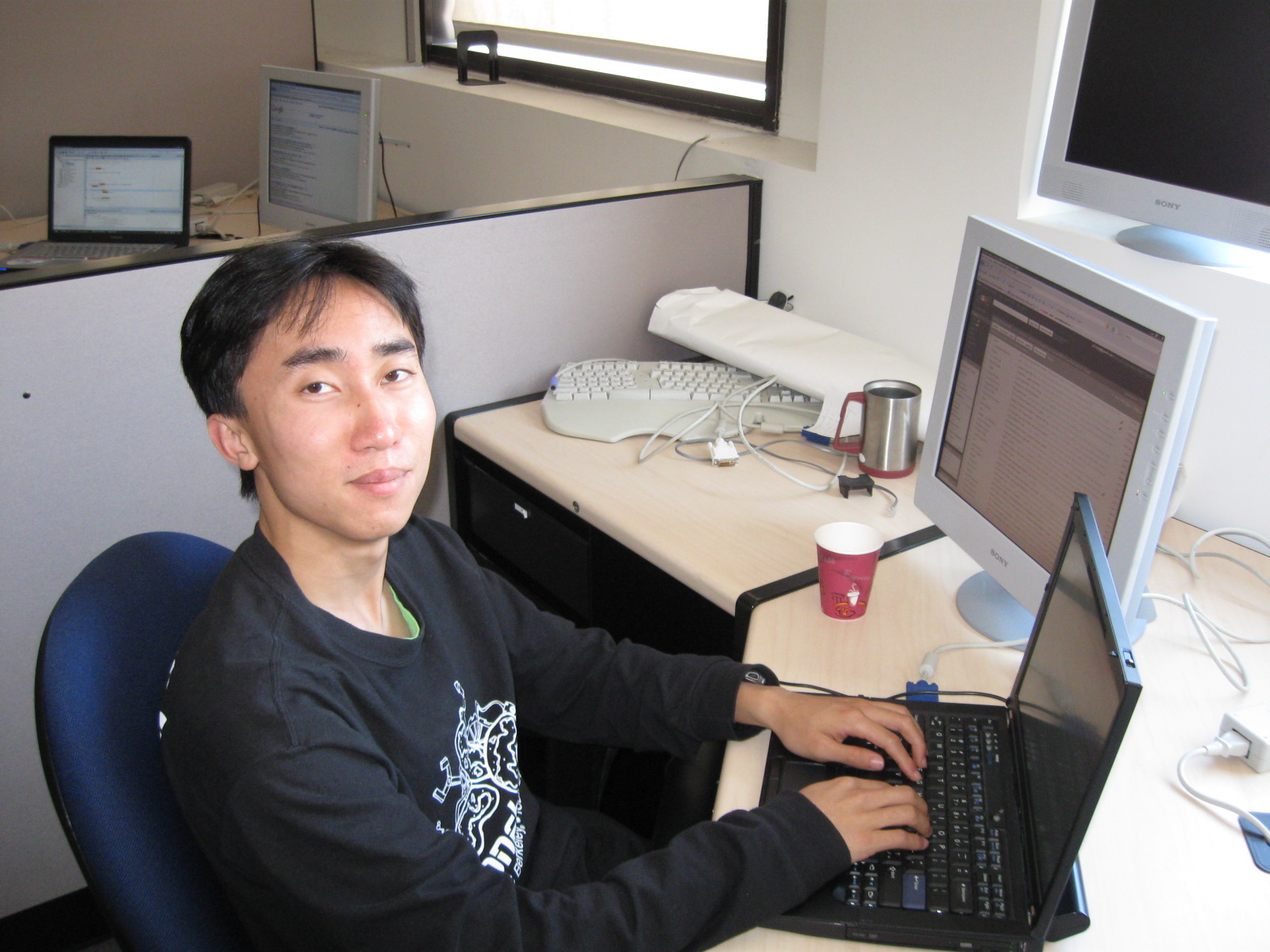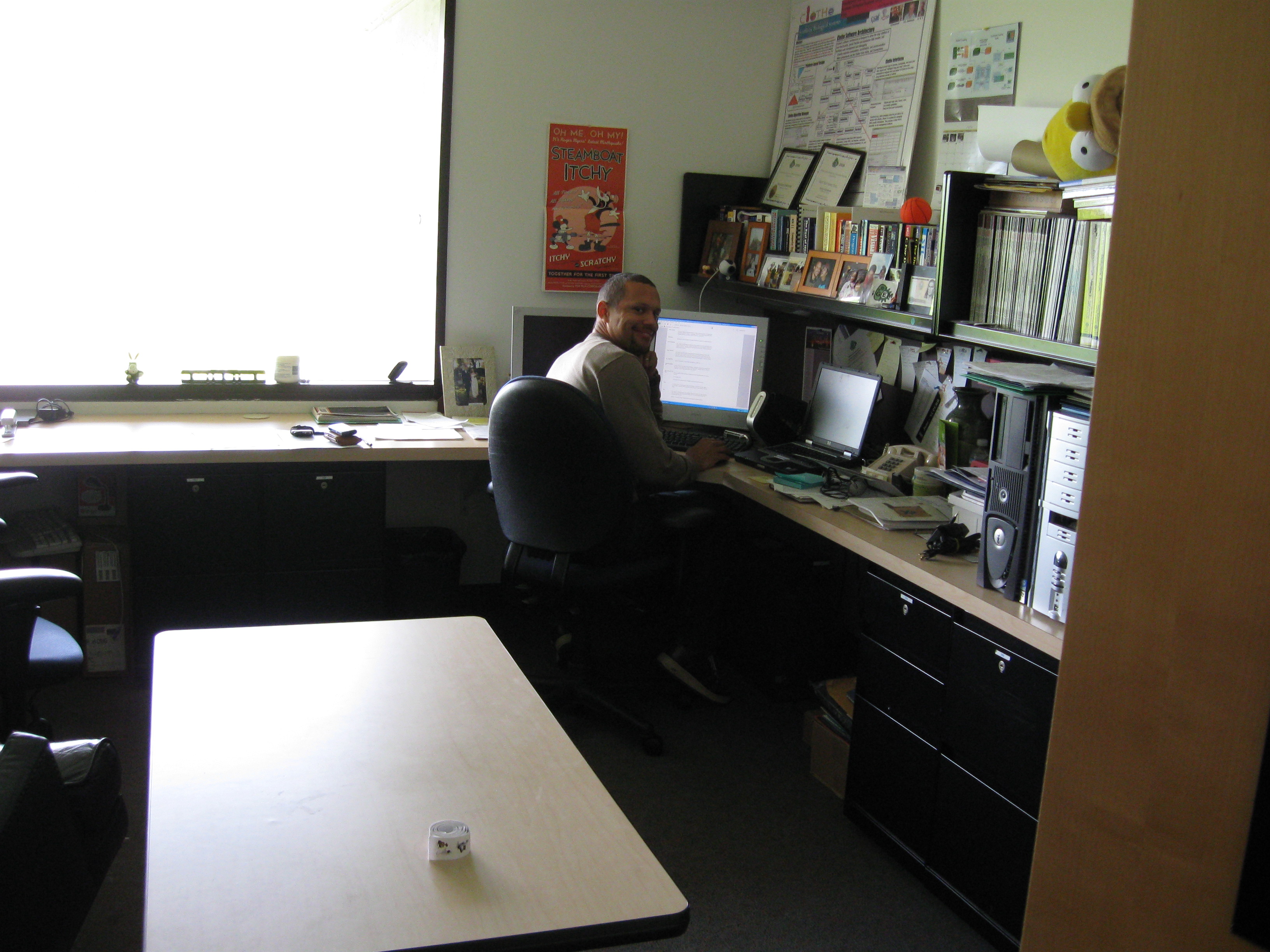Team:Berkeley Software/NinaNotebook
From 2009.igem.org
Contents |
Nina 2 June 2009
Today is the second day of iGEM. Yesterday I spent time looking at java tutorials.
New Tasks Given are to look at tutorials for wiki that will be working or not -- media wiki embedded html for complicated stuff keep clean, so no need to clean up later think of a plug-in 1 wiki entry per week
Nina 3 June 2009
My 1st official entry
I am a member of computational team, majoring in bioengineering in fall 2009.
On Monday my team met, and everyone got acquainted with each other. We are still missing one member Lesie, who will join the team on Monday. After meeting with members of computational team, everyone went for a lab safety training and lunch social, where we met other members and leaders including the participants of the wet lab. Instructors were surprised with the size of this year's iGEM team.
Even though, we started working only on Monday, today is Wednesday, and everyone is overwhelmed with tasks and information. I think that we will adjust very soon and will produce effective results.
We got acquainted with Clotho, NetBeans, some Clotho code and CVS already.
- This week short-term goals:
- search for bugs in Clotho
- edit Notebook
- modify .html help files
- MainToolBar
- MySQLlogin
- Longer short-term goals:
- proof-read and become familiar with the rough draft of paper for assembly of biological parts(implementation of dynamic programming - hash tables in Java - and determining the minimum cost for assembly)
- together with Bing, meet with Chris Anderson and Jenn and learn how the robot works in the wet lab + their protocols (.csv file)
- Long term goal for the 1st part of iGEM:
- Robot/Automation project (brief structure):
- select parts (basic and compound)
- do it through Part Manager - 1 click
- put in Algorithm Manager
- run Assembly Algorithm w/Algorithm Manager Plug-in => record wells and physical locations of the each part
- create 2 protocols (.csv)
- human
- robot
- both protocols should take into account actions that user should perform (grab samples from freezer with appropriate bar code - talk to wet lab members); the way dilution will be performed; the way plates will be managed before the complete assembly takes place (Plate Manager)
- select parts (basic and compound)
--NinaRevko 23:05, 3 June 2009 (UTC)
Nina 5 June 2009
After meeting with J.Christopher Anderson... The questions raised:
- how to delete theoretical parts from the database (with no associated physical part?
- requirements that will be tried to be implemented with the following assumptions:
- start with a single plate where the basic parts are located - are all in 1 plate put there by user
- cell stocks are not taken into account initially
- bring parts in/out - allow for flexibility and playing around with parts
- export assembly tree into a .csv file for robot with taking into account of "left-y", "right-y" and different antibiotics compatibility (AC, CA, AK, KA, CK, KC) - "lefty"/"righty" are currently not specified in db
- after the robot is done and parts were made, display what parts were successful -- allow for user's input (in form of a tree?!)
Nina 10 June 2009
Yesterday I made my first sample plugin. It was not difficult, but took some time to debug and find out what did not work. The plugIn file name should be "plugin.xml" and it is very important to preserve that format. Yesterday I had another meeting with wet lab representatives discussing the robot protocol. Also I had a chance to take a look at the AssemblyAutomationPlugin on which I will be working in the nearest future. Today Jenn from the wet lab sent the protocol they are using for the robot and I am going through analyzing it right now. Some notes:
- min volume for robot - 3ul
- max volume for a single 96well plate - 200 ul
- max volume for pippetting/mixing for robot???
- digest cocktail and lysis mix cannot be done by hand (from Bing)
- stock plate (96 well with mini preps)
- bigStock plate with H2O, buffer, lysis mix, digest cocktail
- dilution plate
- reaction plate
Looking at protocol, there should be several blocks done:
- running the SDS assembly algorithm, determine the amount of every basic part needed for the building of the final goal part(? what to do about the extra volume of the required reagents? multiply the volume by which factor assuming that some stages need to be re-tried?)
- ?should we take into account the amount of the stock and prep sep one for each STAGE?
- done by user at the present time: making basic parts and miniprep (?put in DB); put in 96 well plate at this time
- dilution block (Input--the wells and plate locations of the miniprep and basic parts - if they are in stock plate as specified by the protocol after SDS algo, locations are known); check if the user messed up the plate; the plate with NEB2 Buffer (bigStock)
- ---function to pippet the same reagent in many wells
- ---function to transfer one miniprep from STAGE1 plate into STAGE# plate
- Digest block: (Input--the destination wells from the dilution block & stock of digest cocktail; output - destination wells)
- Ligation block...
--NinaRevko 21:30, 10 June 2009 (UTC)
Nina 15 June 2009
The general meeting took place during regular Monday hours. Presentation of three projects left everyone with full-filling thoughts that something great is happening in our group and that people are totally not familiar what everyone is doing. This meeting and the upcoming Thursday meeting will keep everyone up-to-date and provide certain info-sessions on ongoing projects.
Nina 17 June 2009
I had meeting with my advisor. It took me about 40 minutes to put my thought and my code in order to present it and to talk about it. After the meeting I decided to work on the upcoming presentation that I had to make on Thursday. I spent some time working on presentation. The thoughts start coming in order and new fresh ideas about how the code is supposed to work, developed. I came to the conclusion that my Friday deadline will be missed but that I could finish by Monday...
Nina 20 June 2009
Last week the directions of what to do were clearly stated, the protocol for assembly procedure was obtained and several meetings with Doug Desmore and Chris Anderson was held. The part of the last week and this week I have been working on the assembly plugin.
Ideally my piece fits in the following scheme and should communicate with database (will be implemented later) and algorithm manager:
The work flow of the currently implemented changes will support the following operations:
- take in SDS tree->process it in 3 arrays with data and one array with stages
- based on a stage given by user, the program will pull out all resultant nodes together with lefty/righty parts
- taking into account the future use of the part (as lefty or/and righty or as final product), the resultant nodes are sorted in the order of lefty/none/righty and will be put in wells of the reaction plate in that way
- the initial well assignment to stock, dilution, reaction plate for a single stage is performed by the first method based on resultant usage
- BigStock plate is currently hard-coded and holds dilution buffer (A5/A6) , digestion mix (B5/B6) and ligation mix (C5/C6)
- one to many non-empty assigned/(modify this to do assignment for wells)
- redundancy check for the stock and dilution plates performed, wells reassigned (3 functions)
- destinations and assignments scheduled for destinations are modified and reassigned
- convert everything to 3 files for dilution, reaction and ligation processes
- create user file - instructions for user
More graphical presentation of what the program should do is below:
The basic things to keep in mind:
- min volume to pipette from single channel is 3ul (for accurate pipetting need 8ul in a well
- max -"- 20ul
- robot does mixing and changing of tips automatically
- preferably stuff from Big Stock Plate goes in wells first (email Chris to ask whether it's important)
- allow to integrate between pipette in rows or columns (specificity of the plate in our case, defined by user)
Upcoming work:
- convert destinations to destination parameter class
- finish cleanUpRedundancy function
- modify it to keep track of well assignments
- debugging, debugging, debugging
- go in wet lab to test it
- create GUI with possibilities of user-defined properties like to which file to save; to pick a stage, etc.
Nina 28 June 2009
For the past week I was working on fixing bugs. Over the week my program was able to produce correct output files with no errors =) Hooray!
On Friday, I went to wet lab and found out that they want more from my program that the piece that I made was not enough for them to do the testing. I was a little bit disappointed and worked a lot during week-end fixing and reorganizing pieces. I added:
- a sorter for the resultant parts and populating the reaction plate besides lefty/righty, also according to 6 types of antibiotics
- created an option for user to read in the stock plates from the text file (includes the possibility of having multiple stock plates)
Still to work and to do before showing up in front of the wet team:
- do automatic plate assignment (currently hardcoded)--it is required for the multiple plates
- do the file output for plating
- do the user choice for antibiotic and their reassignment--by user!!!--it should be somewhere in tree
--NinaRevko 07:18, 29 June 2009 (UTC)
Nina 2 July 2009
It is a short week with long coming week-end. But this week was somewhat productive.
Done:
- the user gets one of the 6 choices of antibiotic assignments that s/he can use
- the user can input his/her own file (instead of database which is being worked on right now) for where the parts are coming from for dilution
- supports only specific format .txt--which can be constructed by coping tables from the .xls file:
- the resultant(reaction) plate is being sorted by the program according to Righty/None/Lefty and according to 6 choices of antibiotics within the plate itself
- the plating file for the preparing of culture with antibiotics is produced (the transfer of resultants from the reaction plate to antibiotics plates is made by user using multipippetting channel)
- allows multiple stock plates
- cleans up robot decks from the used plate between steps
- outputs modified user file with instructions
Assumptions:
- no more than 48 wells/resultants can be implemented for one stage (=>no more than 1 dilution plate and one reaction plate are used)
- the final parts for assembly interlink somewhere in between in some of the basic or composite parts (antibiotic distribution assumes sharing)
- the user uses multipippetting channel to pippette buffer into dilution plate
- the user uses multipippetting channel to transfer resultants from reaction plate to platting with antibiotics
- the user has/creates text files or agrees to comply with created stock plates for each stage
Today
Bing and I went to wet lab, talked to Jenn, and we decided to do testing on Tuesday. Jenn should prepare parts that we will use for a simple assembly testing.
TODO before Tuesday:
- clean-up code
- do some testing (look for unfixed bugs)
- consider moving antibiotic selection before the stage selection
- re-do the text window option for the showing of the assigned plates
--NinaRevko 23:16, 2 July 2009 (UTC)
Nina 3 July 2009
Berkeley Comp IGEM Team 2009
Eugene Team
Kepler Team
Visualisation Team
Automation Team
Clotho Data Model
...and the person who also participates in Kepler and Automation teams!
The person without whom there will be no teams...
If we are tired or have no thoughts...
Nina 12 July 2009
This week was somewhat short. On Monday wet and comp teams had the first general social event. On Tuesday I went to wet lab, and the wet lab requested output files in a certain way and some of the parameters to be kept constant. I finished wet lab request by Wednesday, sent email to Jenn about the possible run and received a reply that we can test it on the real parts, but that the run has to be postponed for 2-3 days due to basic parts being in progress. The rest of the week I spent working on fixing of the current interface of the plugging, modifying some functions to accept users input and to allow for the parameters check. I also cleaned up code and bettered my comments on the functions.
Here's the description of my main program in the plugin: What happens here?
The parts from results, leftyParts, rightyParts arrays get picked according to stage index.
The reaction plate is organized first for resultant parts as (Righty/None/Lefty) and each of those
three instances are also sorted by antibiotics; at the same time the stock plate and dilution
plate are organized. Then the cleanUpRedundancy function removes repeating wells if they can be
combined together with other wells holding the same substance. That process is performed for
stock plate, bigStock/enzyme plate and dilution plate (reaction plate is organized from the beginning to exclude
redundancies).
The user gets a chance to view how computer organized the stock plate, and if the user has a his/her stock parts
in a separate/different plate(s), s/he can load a text file and the program will reorganize stock material -
mini-preps - according to user's choice assuming the format of the text file is the following:
PlateName(where the compound is)/[tab]/WellName/[tab]/PartName/[tab]/Antibiotic1(A/K/C)/[tab]/
/Antibiotic2(A/K/C)/[tab]/L or R
These files can be constructed in excel and saved as text documents, then the tab separation between columns is kept.
With manipulation of assignment to the plates and destinations from the plates, files become created for User (with
no extension), and robot: for dilution and reaction.
Then the platting with antibiotics of the resultants is assigned to the platting plates and also .csv files are
created.
Nina 13 July 2009
Today is Monday. The majority of clean up has been done. Now I am waiting for the wet lab to give me basic parts to assemble so I can check them and to decide on the date of the run. Besides that I am looking forward to learn more about my new project. Doug said that I might be able to implement another robot with similar protocol, writing a program for it.
 "
"


